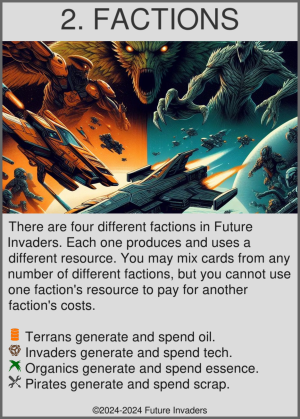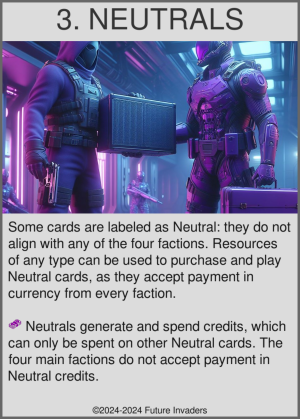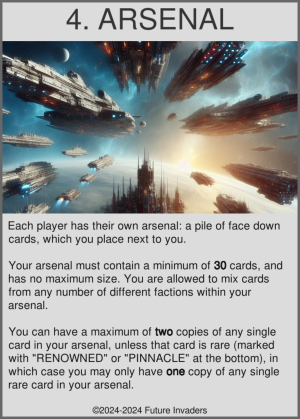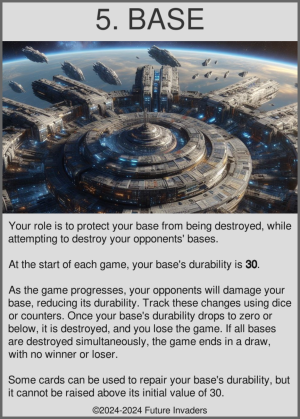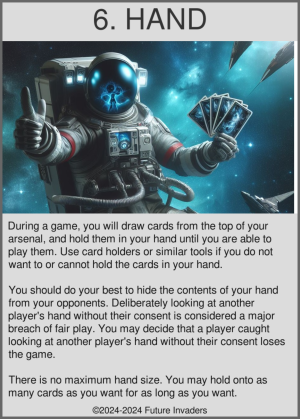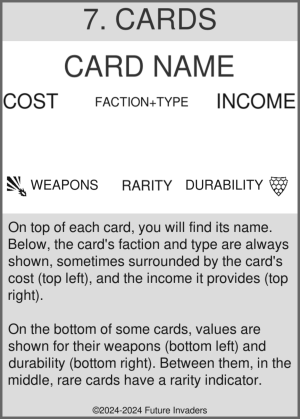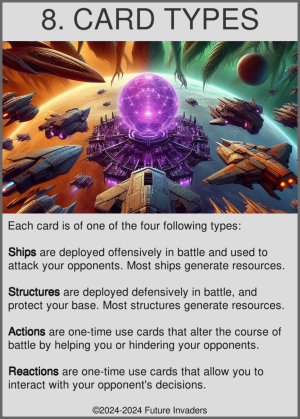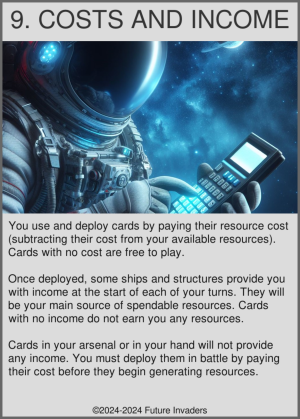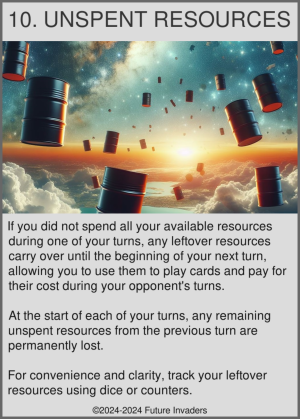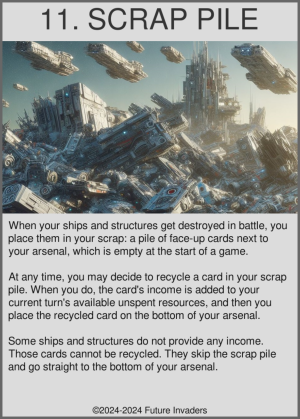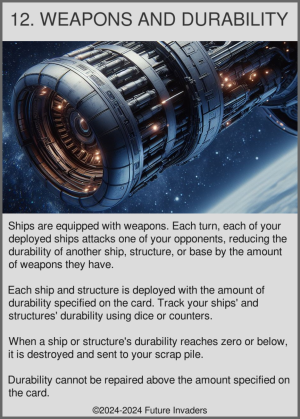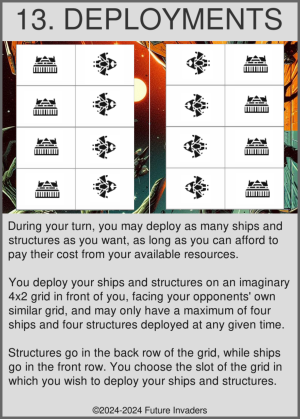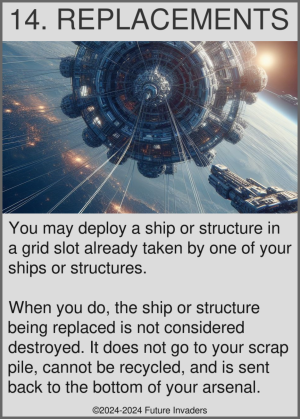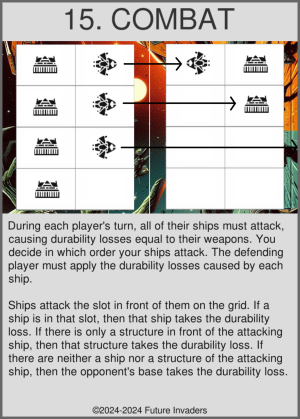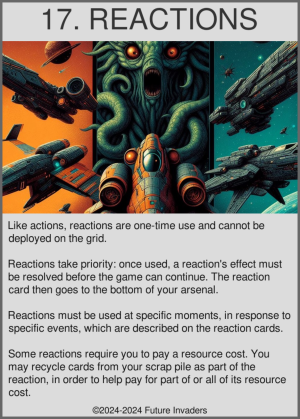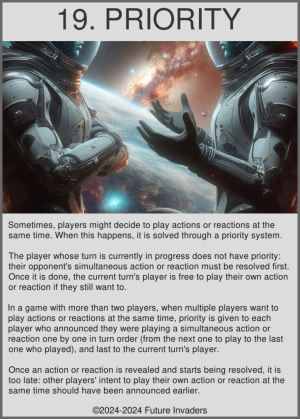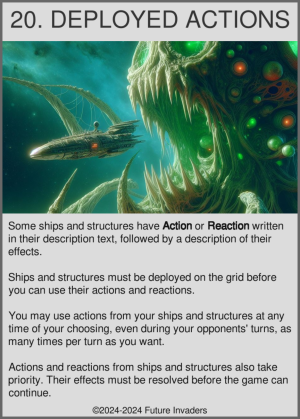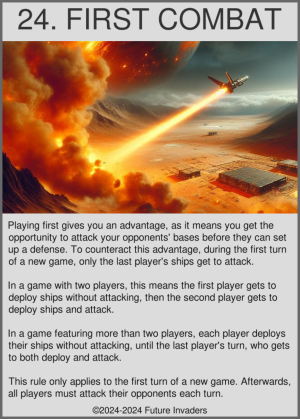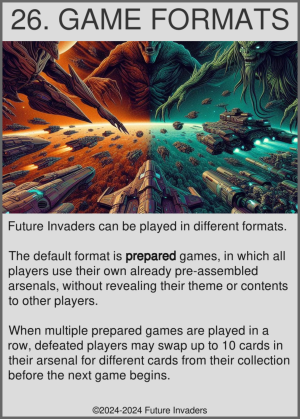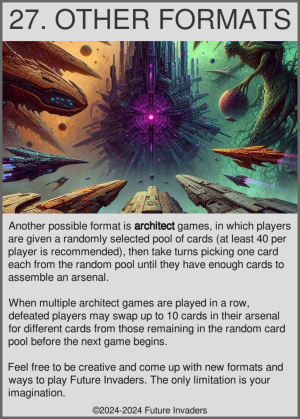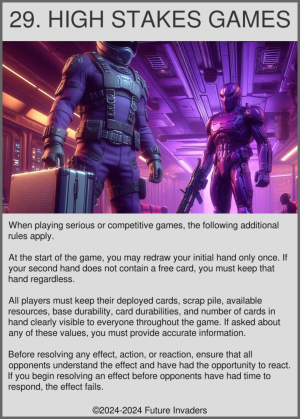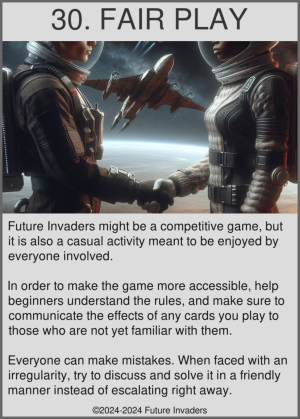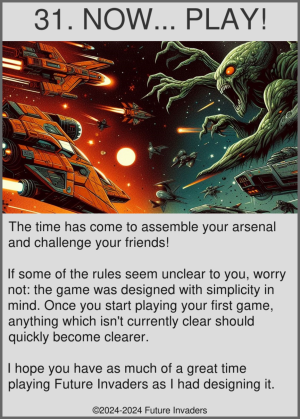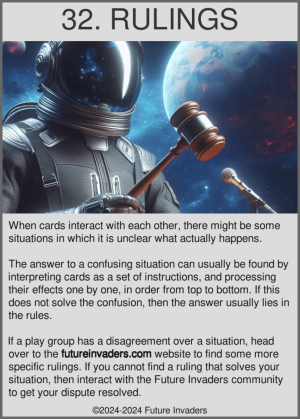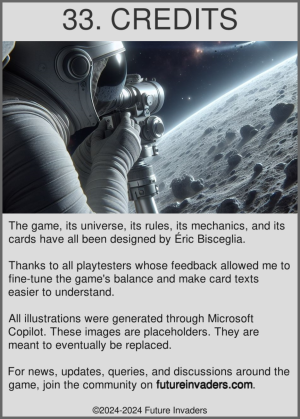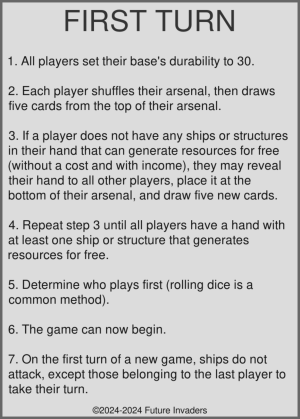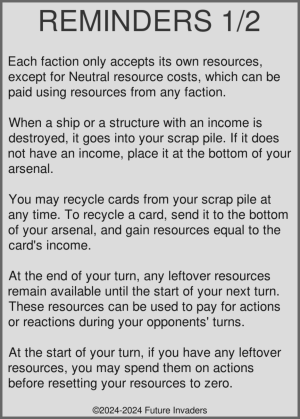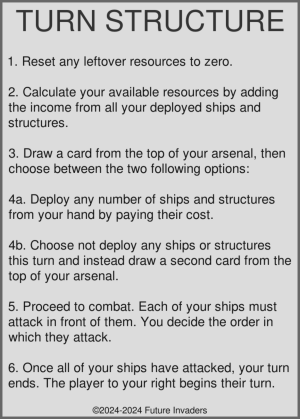Rules of the game
At the bottom of the page, you'll find reminder cards that summarize the rules, including a step-by-step guide to a turn's structure. The website also includes a glossary of terms used in the game.
Rules and reminders are on cards, allowing you to print them at home.
Rules cards
- 01. Future Invaders
- 02. Factions
- 03. Neutrals
- 04. Arsenal
- 05. Base
- 06. Hand
- 07. Cards
- 08. Card types
- 09. Costs and income
- 10. Unspent resources
- 11. Scrap pile
- 12. Weapons and durability
- 13. Deployments
- 14. Replacements
- 15. Combat
- 16. Actions
- 17. Reactions
- 18. Chain reactions
- 19. Priority
- 20. Deployed actions
- 21. Failures
- 22. First turn
- 23. Turn structure
- 24. First combat
- 25. Endgame
- 26. Game formats
- 27. Other formats
- 28. Multiplayer
- 29. High stakes games
- 30. Fair play
- 31. Now... play!
- 32. Rulings
- 33. Credits
Rule reminders
Rules cards
01. Future Invaders
Future Invaders is a strategic card game, set in a war-torn future solar system.
A minimum of two players is required, with no maximum amount.
Players take turns playing cards, eliminating each other until only one player remains.
Optional lore cards describe the game's setting and backstory.
02. Factions
There are four different factions in Future Invaders. Each one produces and uses a different resource. You may mix cards from any number of different factions, but you cannot use one faction's resource to pay for another faction's costs.
![]() Terrans generate and spend oil.
Terrans generate and spend oil.
![]() Invaders generate and spend tech.
Invaders generate and spend tech.
![]() Organics generate and spend essence.
Organics generate and spend essence.
![]() Pirates generate and spend scrap.
Pirates generate and spend scrap.
03. Neutrals
Some cards are labeled as Neutral: they do not align with any of the four factions. Resources of any type can be used to purchase and play Neutral cards, as they accept payment in currency from every faction.
![]() Neutrals generate and spend credits, which can only be spent on other Neutral cards. The four main factions do not accept payment in Neutral credits.
Neutrals generate and spend credits, which can only be spent on other Neutral cards. The four main factions do not accept payment in Neutral credits.
04. Arsenal
Each player has their own arsenal: a pile of face down cards, which you place next to you.
Your arsenal must contain a minimum of 30 cards, and has no maximum size. You are allowed to mix cards from any number of different factions within your arsenal.
You can have a maximum of two copies of any single card in your arsenal, unless that card is rare (marked with "RENOWNED" or "PINNACLE" at the bottom), in which case you may only have one copy of any single rare card in your arsenal.
05. Base
Your role is to protect your base from being destroyed, while attempting to destroy your opponents' bases.
At the start of each game, your base's durability is 30.
As the game progresses, your opponents will damage your base, reducing its durability. Track these changes using dice or counters. Once your base's durability drops to zero or below, it is destroyed, and you lose the game. If all bases are destroyed simultaneously, the game ends in a draw, with no winner or loser.
Some cards can be used to repair your base's durability, but it cannot be raised above its initial value of 30.
06. Hand
During a game, you will draw cards from the top of your arsenal, and hold them in your hand until you are able to play them. Use card holders or similar tools if you do not want to or cannot hold the cards in your hand.
You should do your best to hide the contents of your hand from your opponents. Deliberately looking at another player's hand without their consent is considered a major breach of fair play. You may decide that a player caught looking at another player's hand without their consent loses the game.
There is no maximum hand size. You may hold onto as many cards as you want for as long as you want.
07. Cards
On top of each card, you will find its name. Below, the card's faction and type are always shown, sometimes surrounded by the card's cost (top left), and the income it provides (top right).
On the bottom of some cards, values are shown for their weapons (bottom left) and durability (bottom right). Between them, in the middle, rare cards have a rarity indicator.
08. Card types
Each card is of one of the four following types:
Ships are deployed offensively in battle and used to attack your opponents. Most ships generate resources.
Structures are deployed defensively in battle, and protect your base. Most structures generate resources.
Actions are one-time use cards that alter the course of battle by helping you or hindering your opponents.
Reactions are one-time use cards that allow you to interact with your opponent's decisions.
09. Costs and income
You use and deploy cards by paying their resource cost (subtracting their cost from your available resources). Cards with no cost are free to play.
Once deployed, some ships and structures provide you with income at the start of each of your turns. They will be your main source of spendable resources. Cards with no income do not earn you any resources.
Cards in your arsenal or in your hand will not provide any income. You must deploy them in battle by paying their cost before they begin generating resources.
10. Unspent resources
If you did not spend all your available resources during one of your turns, any leftover resources carry over until the beginning of your next turn, allowing you to use them to play cards and pay for their cost during your opponent's turns.
At the start of each of your turns, any remaining unspent resources from the previous turn are permanently lost.
For convenience and clarity, track your leftover resources using dice or counters.
11. Scrap pile
When your ships and structures get destroyed in battle, you place them in your scrap: a pile of face-up cards next to your arsenal, which is empty at the start of a game.
At any time, you may decide to recycle a card in your scrap pile. When you do, the card's income is added to your current turn's available unspent resources, and then you place the recycled card on the bottom of your arsenal.
Some ships and structures do not provide any income. Those cards cannot be recycled. They skip the scrap pile and go straight to the bottom of your arsenal.
12. Weapons and durability
Ships are equipped with weapons. Each turn, each of your deployed ships attacks one of your opponents, reducing the durability of another ship, structure, or base by the amount of weapons they have.
Each ship and structure is deployed with the amount of durability specified on the card. Track your ships' and structures' durability using dice or counters.
When a ship or structure's durability reaches zero or below, it is destroyed and sent to your scrap pile.
Durability cannot be repaired above the amount specified on the card.
13. Deployments
During your turn, you may deploy as many ships and structures as you want, as long as you can afford to pay their cost from your available resources.
You deploy your ships and structures on an imaginary 4x2 grid in front of you, facing your opponents' own similar grid, and may only have a maximum of four ships and four structures deployed at any given time.
Structures go in the back row of the grid, while ships go in the front row. You choose the slot of the grid in which you wish to deploy your ships and structures.
14. Replacements
You may deploy a ship or structure in a grid slot already taken by one of your ships or structures.
When you do, the ship or structure being replaced is not considered destroyed. It does not go to your scrap pile, cannot be recycled, and is sent back to the bottom of your arsenal.
15. Combat
During each player's turn, all of their ships must attack, causing durability losses equal to their weapons. You decide in which order your ships attack. The defending player must apply the durability losses caused by each ship.
Ships attack the slot in front of them on the grid. If a ship is in that slot, then that ship takes the durability loss. If there is only a structure in front of the attacking ship, then that structure takes the durability loss. If there are neither a ship nor a structure of the attacking ship, then the opponent's base takes the durability loss.
16. Actions
Actions are one-time use, and cannot be deployed on the grid.
Actions can be used at any time of your choosing, even during your opponents' turns. Actions take priority: when you use an action, the game pauses, and the action's effect must be resolved before the game can continue. The action card then goes to the bottom of your arsenal.
Actions cannot be used in response to another action: an action must be be resolved before the next one can be used.
Some actions require you to pay a resource cost. You may recycle cards from your scrap pile as part of the action, in order to help pay for part of or all of its resource cost.
17. Reactions
Like actions, reactions are one-time use and cannot be deployed on the grid.
Reactions take priority: once used, a reaction's effect must be resolved before the game can continue. The reaction card then goes to the bottom of your arsenal.
Reactions must be used at specific moments, in response to specific events, which are described on the reaction cards.
Some reactions require you to pay a resource cost. You may recycle cards from your scrap pile as part of the reaction, in order to help pay for part of or all of its resource cost.
18. Chain reactions
Some reactions can be used in response to actions or to other reactions. This can create a chain reaction.
Once a chain of reactions begins, you cannot react to the event which started the chain, only to the latest reaction to have been added to the chain.
You resolve these chains in the order they took over priority. This means you resolve them one by one, in reverse order: the reaction that was played last must be resolved first, then the one which was played before it, etc., until you reach the event which started the chain reaction. The game can then resume.
19. Priority
Sometimes, players might decide to play actions or reactions at the same time. When this happens, it is solved through a priority system.
The player whose turn is currently in progress does not have priority: their opponent's simultaneous action or reaction must be resolved first. Once it is done, the current turn's player is free to play their own action or reaction if they still want to.
In a game with more than two players, when multiple players want to play actions or reactions at the same time, priority is given to each player who announced they were playing a simultaneous action or reaction one by one in turn order (from the next one to play to the last one who played), and last to the current turn's player.
Once an action or reaction is revealed and starts being resolved, it is too late: other players' intent to play their own action or reaction at the same time should have been announced earlier.
20. Deployed actions
Some ships and structures have Action or Reaction written in their description text, followed by a description of their effects.
Ships and structures must be deployed on the grid before you can use their actions and reactions.
You may use actions from your ships and structures at any time of your choosing, even during your opponents' turns, as many times per turn as you want.
Actions and reactions from ships and structures also take priority. Their effects must be resolved before the game can continue.
21. Failures
Some card effects might state that an event fails. In that case, the failed event does not happen. You do not get reimbursed for the cost of the failed event. Any spent resources are gone.
When a ship or a structure fails to deploy, it is not destroyed. It does not get sent to your scrap pile. Instead, it goes to the bottom of your arsenal.
Other card effects might state that a card is removed from the game. When this happens, the removed card is permanently gone, and cannot be used anymore. You do not put the removed card in your scrap pile or on the bottom of your arsenal, but rather set it aside until the game ends.
22. First turn
Players must decide who plays first. You can make a friendly agreement, roll dice, or use any other method of your choosing.
Each player shuffles their arsenal, then draws five cards into their hand from the top of their arsenal. If none of the cards in your hand can generate resources for free (ships or structures which have no cost and generate income), you may reveal your hand to your opponents, place the five cards at the bottom of your arsenal, and draw five new cards. Each player may repeat this step as many times as they want.
Once this is done, everyone sets their base's durability to 30, then your game of Future Invaders can begin.
23. Turn structure
You begin your turn by resetting your leftover resources to zero. Then, you calculate your available resources by counting the income generated by your deployed ships and structures.
Next, you draw a card from the top of your arsenal.
Then, you must decide between either deploying as many ships and structures as you want from your hand, or skipping deployments this turn and drawing a second card from the top of your arsenal. You may still use actions and reactions even if you choose to skip deploying ships and structures.
Lastly, each of your ships attacks in front of them. Once combat is over, the turn of the player to your right can begin.
24. First combat
Playing first gives you an advantage, as it means you get the opportunity to attack your opponents' bases before they can set up a defense. To counteract this advantage, during the first turn of a new game, only the last player's ships get to attack.
In a game with two players, this means the first player gets to deploy ships without attacking, then the second player gets to deploy ships and attack.
In a game featuring more than two players, each player deploys their ships without attacking, until the last player's turn, who gets to both deploy and attack.
This rule only applies to the first turn of a new game. Afterwards, all players must attack their opponents each turn.
25. Endgame
Once only one player's base remains, they win the game.
A player may surrender at any time, in which case they lose. If two or more other players remain, the game continues.
All players may agree on a draw at any time, for any reason of their choosing. The game then ends with no winner.
If you have no cards left to draw in your arsenal, you lose the game. You can usually avoid this situation by playing cards and recycling your scrap pile.
26. Game formats
Future Invaders can be played in different formats.
The default format is prepared games, in which all players use their own already pre-assembled arsenals, without revealing their theme or contents to other players.
When multiple prepared games are played in a row, defeated players may swap up to 10 cards in their arsenal for different cards from their collection before the next game begins.
27. Other formats
Another possible format is architect games, in which players are given a randomly selected pool of cards (at least 40 per player is recommended), then take turns picking one card each from the random pool until they have enough cards to assemble an arsenal.
When multiple architect games are played in a row, defeated players may swap up to 10 cards in their arsenal for different cards from those remaining in the random card pool before the next game begins.
Feel free to be creative and come up with new formats and ways to play Future Invaders. The only limitation is your imagination.
28. Multiplayer
When there are more than two players in a game, your 4x2 grid is split into two separate 2x2 grids, facing your physically closest opponents on each side. As opponents get eliminated, your deployed ships and structures might have to be moved to always be facing your closest remaining opponents.
The left half of your grid attacks and defends against the player to your left, while the right half of your grid attacks and defends against the player to your right.
Any number of players may participate in a game. Alliances and betrayals are encouraged. Keep in mind that your ships are forced to attack on each of your turns.
29. High stakes games
When playing serious or competitive games, the following additional rules apply.
At the start of the game, you may redraw your initial hand only once. If your second hand does not contain a free card, you must keep that hand regardless.
All players must keep their deployed cards, scrap pile, available resources, base durability, card durabilities, and number of cards in hand clearly visible to everyone throughout the game. If asked about any of these values, you must provide accurate information.
Before resolving any effect, action, or reaction, ensure that all opponents understand the effect and have had the opportunity to react. If you begin resolving an effect before opponents have had time to respond, the effect fails.
30. Fair play
Future Invaders might be a competitive game, but it is also a casual activity meant to be enjoyed by everyone involved.
In order to make the game more accessible, help beginners understand the rules, and make sure to communicate the effects of any cards you play to those who are not yet familiar with them.
Everyone can make mistakes. When faced with an irregularity, try to discuss and solve it in a friendly manner instead of escalating right away.
31. Now... play!
The time has come to assemble your arsenal and challenge your friends!
If some of the rules seem unclear to you, worry not: the game was designed with simplicity in mind. Once you start playing your first game, anything which isn't currently clear should quickly become clearer.
I hope you have as much of a great time playing Future Invaders as I had designing it.
32. Rulings
When cards interact with each other, there might be some situations in which it is unclear what actually happens.
The answer to a confusing situation can usually be found by interpreting cards as a set of instructions, and processing their effects one by one, in order from top to bottom. If this does not solve the confusion, then the answer usually lies in the rules.
If a play group has a disagreement over a situation, head over to the futureinvaders.com website to find some more specific rulings. If you cannot find a ruling that solves your situation, then interact with the Future Invaders community to get your dispute resolved.
33. Credits
The game, its universe, its rules, its mechanics, and its cards have all been designed by Éric Bisceglia.
Thanks to all playtesters whose feedback allowed me to fine-tune the game's balance and make card texts easier to understand.
All illustrations were generated through Microsoft Copilot. These images are placeholders. They are meant to eventually be replaced.
For news, updates, queries, and discussions around the game, join the community on futureinvaders.com.
Rule reminders
First turn
1. All players set their base's durability to 30.
2. Each player shuffles their arsenal, then draws five cards from the top of their arsenal.
3. If a player does not have any ships or structures in their hand that can generate resources for free (without a cost and with income), they may reveal their hand to all other players, place it at the bottom of their arsenal, and draw five new cards.
4. Repeat step 3 until all players have a hand with at least one ship or structure that generates resources for free.
5. Determine who plays first (rolling dice is a common method).
6. The game can now begin.
7. On the first turn of a new game, ships do not attack, except those belonging to the last player to take their turn.
Reminders 1/2
Each faction only accepts its own resources, except for Neutral resource costs, which can be paid using resources from any faction.
When a ship or a structure with an income is destroyed, it goes into your scrap pile. If it does not have an income, place it at the bottom of your arsenal.
You may recycle cards from your scrap pile at any time. To recycle a card, send it to the bottom of your arsenal, and gain resources equal to the card's income.
At the end of your turn, any leftover resources remain available until the start of your next turn. These resources can be used to pay for actions or reactions during your opponents' turns.
At the start of your turn, if you have any leftover resources, you may spend them on actions before resetting your resources to zero.
Reminders 2/2
When a player uses an action or a reaction, the game is paused until its effect is resolved. The only thing that can override this pause is using a reaction in response to that action or reaction, which starts a chain reaction.
When you replace one of your ships or structures with another, the card being replaced is not considered destroyed and cannot be scrapped. Instead, place it at the bottom of your arsenal.
Ships, structures, and bases cannot be repaired beyond their initial durability value.
If a reaction causes a card to fail to deploy, the card is not destroyed or scrapped. Instead, it is placed at the bottom of its owner's arsenal.
In games with more than two players, your 4x2 grid is divided into two 2x2 grids, each facing the players closest to you.
Turn structure
1. Reset any leftover resources to zero.
2. Calculate your available resources by adding the income from all your deployed ships and structures.
3. Draw a card from the top of your arsenal, then choose between the two following options:
4a. Deploy any number of ships and structures from your hand by paying their cost.
4b. Choose not deploy any ships or structures this turn and instead draw a second card from the top of your arsenal.
5. Proceed to combat. Each of your ships must attack in front of them. You decide the order in which they attack.
6. Once all of your ships have attacked, your turn ends. The player to your right begins their turn.

